Uncertainty Analysis of Factors Influencing Stimulated Fracture Volume in Layered Formation
Abstract
:1. Introduction
2. Methodology
2.1. Theoretical Background
2.2. Model Setup
- (1)
- The formation is isotropic pore material.
- (2)
- Initial stress gradient is evenly distributed in each layer.
- (3)
- Interface slippage between reservoir and barrier is not considered.
- (4)
- Fluid in the pores is incompressible.
2.3. Experimental Design
2.3.1. Response Surface Method
2.3.2. Box–Behnken Design
3. Results
3.1. Hurricane Analysis of Multiple Factors
3.2. Response Surface Analysis of Variables to SRV
4. Discussion
4.1. Effect of the Injection Rate
4.2. Effect of the Young’s Modulus
4.3. Effect of the Poisson’s Ratio
4.4. Effect of the Permeability Coefficient
5. Conclusions
- (1)
- To screen the significant influencing factors and determine the optimal level combination, the quadratic response surface model was established. The statistical analysis of the F value and p-value of regression equations implies that the model has a high degree of fitting, which is beneficial for analyzing and predicting the hydraulic behavior of fracturing in a layered formation.
- (2)
- The injection rate and Young’s modulus are the most significant factors to SRV among all the independent variables. A high pumping rate provides enough energy to form a hydraulic fracture with a wide range. The reservoir with high Young’s modulus typically generates high pressure, leading to longer fractures and larger SRV. SRV reaches the maximum value when E1 and E2 are high, which indicates that E1 and E2 are positively correlated with SRV.
- (3)
- When the reservoir Poisson’s ratio (μ1) is low, the fracture is wide, but the SRV reaches the maximum and is negatively correlated with μ1. Once the tip of the fracture crosses the interface, the high barrier Poisson’s ratio (μ2) has a relatively weak effect on inhibiting the fracture growth, and consequently, increasing the fracture extension range. Moreover, the lower the reservoir permeability coefficient (K1), the more fluid remains in the fracture rather than being lost in the formation; thus, SRV is negatively correlated with K1.
- (4)
- Different interactions affect the SRV to varying degrees. In general, maintaining a high injection rate in this layered formation with high E1 and E2, and relatively low K1 and μ1 at about 0.25, would be beneficial to form a larger SRV.
Author Contributions
Funding
Conflicts of Interest
References
- Lecampion, B.; Bunger, A.; Zhang, X. Numerical methods for hydraulic fracture propagation: A review of recent trends. J. Nat. Gas Sci. Eng. 2018, 49, 66–83. [Google Scholar] [CrossRef]
- Daneshy, A.A. On the design of vertical hydraulic fractures. J. Pet. Technol. 1973, 25, 83–97. [Google Scholar] [CrossRef]
- Nordgren, R. Propagation of a vertical hydraulic fracture. Soc. Pet. Eng. J. 1972, 12, 306–314. [Google Scholar] [CrossRef]
- Abé, H.; Keer, L.M.; Mura, T. Growth rate of a penny-shaped crack in hydraulic fracturing of rocks, 2. J. Geophys. Res. 1976, 81, 6292–6298. [Google Scholar] [CrossRef]
- Settari, A.; Cleary, M.P. Development and testing of a pseudo-three-dimensional model of hydraulic fracture geometry. SPE Prod. Eng. 1986, 1, 449–466. [Google Scholar] [CrossRef]
- Carter, B.; Desroches, J.; Ingraffea, A.; Wawrzynek, P. Simulating fully 3D hydraulic fracturing. Model. Geomech. 2000, 200, 525–557. [Google Scholar]
- Park, S.; Kim, K.-I.; Kwon, S.; Yoo, H.; Xie, L.; Min, K.-B.; Kim, K.Y. Development of a hydraulic stimulation simulator toolbox for enhanced geothermal system design. Renew. Energy 2018, 118, 879–895. [Google Scholar] [CrossRef]
- Clarkson, C.R.; Williams-Kovacs, J.D. A New Method for Modeling Multi-Phase Flowback of Multi-Fractured Horizontal Tight Oil Wells to Determine Hydraulic Fracture Properties. In Proceedings of the SPE Annual Technical Conference and Exhibition, New Orleans, LA, USA, 30 September–2 October 2013. [Google Scholar]
- Dongyan, F.; Jun, Y.; Hai, S.; Hui, Z.; Wei, W. A composite model of hydraulic fractured horizontal well with stimulated reservoir volume in tight oil & gas reservoir. J. Nat. Gas Sci. Eng. 2015, 24, 115–123. [Google Scholar]
- Li, Y.; Deng, J.G.; Liu, W.; Feng, Y. Modeling hydraulic fracture propagation using cohesive zone model equipped with frictional contact capability. Comput. Geotech. 2017, 91, 58–70. [Google Scholar] [CrossRef]
- Guo, J.; Luo, B.; Lu, C.; Lai, J.; Ren, J. Numerical investigation of hydraulic fracture propagation in a layered reservoir using the cohesive zone method. Eng. Fract. Mech. 2017, 186, 195–207. [Google Scholar] [CrossRef]
- Wang, X.; Shi, F.; Liu, C.; Lu, D.; Liu, H.; Wu, H. Extended finite element simulation of fracture network propagation in formation containing frictional and cemented natural fractures. J. Nat. Gas Sci. Eng. 2018, 50, 309–324. [Google Scholar] [CrossRef]
- Ren, J.; Guo, P. Nonlinear flow model of multiple fractured horizontal wells with stimulated reservoir volume including the quadratic gradient term. J. Hydrol. 2017, 554, 155–172. [Google Scholar] [CrossRef]
- Guo, T.; Wang, X.; Li, Z.; Gong, F.; Lin, Q.; Qu, Z.; Lv, W.; Tian, Q.; Xie, Z. Numerical simulation study on fracture propagation of zipper and synchronous fracturing in hydrogen energy development. Int. J. Hydrogen Energy 2019, 44, 5270–5285. [Google Scholar] [CrossRef]
- Li, Q.; Lu, Y.; Ge, Z.; Zhou, Z.; Zheng, J.; Xiao, S. A New Tree-Type Fracturing Method for Stimulating Coal Seam Gas Reservoirs. Energies 2017, 10, 1388. [Google Scholar] [CrossRef]
- Wang, W.; Su, Y.; Yuan, B.; Wang, K.; Cao, X. Numerical Simulation of Fluid Flow through Fractal-Based Discrete Fractured Network. Energies 2018, 11, 286. [Google Scholar] [CrossRef]
- Cipolla, C.L.; Maxwell, S.C.; Mack, M.G. Engineering Guide to the Application of Microseismic Interpretations. In Proceedings of the SPE Hydraulic Fracturing Technology Conference, The Woodlands, TX, USA, 6–8 February 2012; Society of Petroleum Engineers: The Woodlands, TX, USA, 2012. [Google Scholar]
- Patterson, R.; Yu, W.; Wu, K. Integration of microseismic data, completion data, and production data to characterize fracture geometry in the Permian Basin. J. Nat. Gas Sci. Eng. 2018, 56, 62–71. [Google Scholar] [CrossRef]
- Zhao, Y.-L.; Zhang, L.-H.; Luo, J.-X.; Zhang, B.-N. Performance of fractured horizontal well with stimulated reservoir volume in unconventional gas reservoir. J. Hydrol. 2014, 512, 447–456. [Google Scholar] [CrossRef]
- Al-Rbeawi, S. How much stimulated reservoir volume and induced matrix permeability could enhance unconventional reservoir performance. J. Nat. Gas Sci. Eng. 2017, 46, 764–781. [Google Scholar] [CrossRef]
- Li, W.; Schmitt, D.R.; Tibbo, M.; Zou, C. A Program to Calculate the State of Stress in The Vicinity of an Inclined Borehole Through an Anisotropic Rock Formation. Geophysics 2019, 84, 1–88. [Google Scholar] [CrossRef]
- Tian, F.; Du, X.; Wang, X.; Xu, W. Rate decline analysis for finite conductivity vertical fractured gas wells produced under a variable inner boundary condition. J. Pet. Sci. Eng. 2018, 171, 1249–1259. [Google Scholar] [CrossRef]
- Zhang, D.; Dai, Y.; Ma, X.; Zhang, L.; Zhong, B.; Wu, J.; Tao, Z. An Analysis for the Influences of Fracture Network System on Multi-Stage Fractured Horizontal Well Productivity in Shale Gas Reservoirs. Energies 2018, 11, 414. [Google Scholar] [CrossRef]
- Chen, C.; Yang, L.; Jia, R.; Sun, Y.; Guo, W.; Chen, Y.; Li, X. Simulation study on the effect of fracturing technology on the production efficiency of natural gas hydrate. Energies 2017, 10, 1241. [Google Scholar] [CrossRef]
- Dong, T.; Harris, N.B.; Ayranci, K.; Yang, S. The impact of rock composition on geomechanical properties of a shale formation: Middle and Upper Devonian Horn River Group shale, Northeast British Columbia, Canada. AAPG Bull. 2017, 101, 177–204. [Google Scholar] [CrossRef]
- Ripudaman, M.; Mani, S.M.; Shawn, H. Time-dependent fracture-interference effects in pad wells. SPE Prod. Oper. 2014, 29, 274–287. [Google Scholar]
- Wang, X.; Liu, C.; Wang, H.; Liu, H.; Wu, H. Comparison of consecutive and alternate hydraulic fracturing in horizontal wells using XFEM-based cohesive zone method. J. Pet. Sci. Eng. 2016, 143, 14–25. [Google Scholar] [CrossRef]
- Weng, X.; Settari, A.; Keck, R.G. A field demonstration of hydraulic fracturing for solids waste disposal—Injection pressure analysis. Int. J. Rock Mech. Min. Sci. 1997, 34, 331. [Google Scholar] [CrossRef]
- Wu, K.; Olson, J.E. Investigation of the impact of fracture spacing and fluid properties for interfering simultaneously or sequentially generated hydraulic fractures. SPE Prod. Oper. 2013, 28, 427–436. [Google Scholar] [CrossRef]
- Chen, Z.; Jeffrey, R.G.; Zhang, X.; Kear, J. Finite-element simulation of a hydraulic fracture interacting with a natural fracture. SPE J. 2017, 22, 219–234. [Google Scholar] [CrossRef]
- Yong, Y.K.; Maulianda, B.; Wee, S.C.; Mohshim, D.; Elraies, K.A.; Wong, R.C.K.; Gates, I.D.; Eaton, D. Determination of stimulated reservoir volume and anisotropic permeability using analytical modelling of microseismic and hydraulic fracturing parameters. J. Nat. Gas Sci. Eng. 2018, 58, 234–240. [Google Scholar] [CrossRef]
- Ashley, W.J.; Panja, P.; Deo, M. Surrogate models for production performance from heterogeneous shales. J. Pet. Sci. Eng. 2017, 159, 244–256. [Google Scholar] [CrossRef]
- Myers, R.H.; Montgomery, D.C.; Anderson-Cook, C.M. Response Surface Methodology: Process. and Product Optimization Using Designed Experiments; John Wiley & Sons: Hoboken, NJ, USA, 2016. [Google Scholar]
- Wang, Y.; Li, X.; Zhang, B.; Zhao, Z. Optimization of multiple hydraulically fractured factors to maximize the stimulated reservoir volume in silty laminated shale formation, Southeastern Ordos Basin, China. J. Pet. Sci. Eng. 2016, 145, 370–381. [Google Scholar] [CrossRef]
- Wei, X.; Fan, X.; Li, F.; Liu, X.; Liang, L.; Li, Q. Uncertainty analysis of hydraulic fracture height containment in a layered formation. Environ. Earth Sci. 2018, 77, 664. [Google Scholar] [CrossRef]
- Yu, W.; Sepehrnoori, K. Optimization of Multiple Hydraulically Fractured Horizontal Wells in Unconventional Gas Reservoirs. J. Pet. Eng. 2013, 2013, 151898. [Google Scholar]
- Dugdale, D.S. Yielding of steel sheets containing slits. J. Mech. Phys. Solids 1960, 8, 100–104. [Google Scholar] [CrossRef]
- Barenblatt, G.I. The mathematical theory of equilibrium cracks in brittle fracture. Adv. Appl. Mech. 1962, 7, 55–129. [Google Scholar]
- Shen, X.; Cullick, S. Numerical Modeling of Fracture Complexity with Application to Production Stimulation. In Proceedings of the SPE Hydraulic Fracturing Technology Conference, The Woodlands, TX, USA, 6–8 February 2012; Society of Petroleum Engineers: The Woodlands, TX, USA, 2012. [Google Scholar]
- Yao, Y. Linear elastic and cohesive fracture analysis to model hydraulic fracture in brittle and ductile rocks. Rock Mech. Rock Eng. 2012, 45, 375–387. [Google Scholar] [CrossRef]
- Carrier, B.; Granet, S. Numerical modeling of hydraulic fracture problem in permeable medium using cohesive zone model. Eng. Fract. Mech. 2012, 79, 312–328. [Google Scholar] [CrossRef] [Green Version]
- Benzeggagh, M.L.; Kenane, M.J.C.S. Measurement of mixed-mode delamination fracture toughness of unidirectional glass/epoxy composites with mixed-mode bending apparatus. Compos. Sci. Technol. 1996, 56, 439–449. [Google Scholar] [CrossRef]
- Shet, C.; Chandra, N. Analysis of energy balance when using cohesive zone models to simulate fracture processes. J. Eng. Mater. Technol. 2002, 124, 440–450. [Google Scholar] [CrossRef]
- Box, G.E.P.; Hunter, J.S. Multi-Factor Experimental Designs for Exploring Response Surfaces. Ann. Math. Stat. 1957, 28, 195–241. [Google Scholar] [CrossRef]
- Box, G.E.; Wilson, K.B. On the experimental attainment of optimum conditions. J. Royal Stat. Soc. Ser. B 1951, 13, 270–310. [Google Scholar] [CrossRef]
- Steinberg, D.M.; Kenett, R.S. Response Surface Methodology; Wiley: Hoboken, NJ, USA, 2009; pp. 1171–1179. [Google Scholar]
- Box, G.E.; Behnken, D.W. Some new three level designs for the study of quantitative variables. Technometrics 1960, 2, 455–475. [Google Scholar] [CrossRef]
- Yang, C.; Sharma, V.K.; Datta-Gupta, A.; King, M.J. Novel approach for production transient analysis of shale reservoirs using the drainage volume derivative. J. Pet. Sci. Eng. 2017, 159, 8–24. [Google Scholar] [CrossRef]
- Zou, J.; Chen, W.; Yuan, J.; Yang, D.; Yang, J. 3-D numerical simulation of hydraulic fracturing in a CBM reservoir. J. Nat. Gas Sci. Eng. 2017, 37, 386–396. [Google Scholar] [CrossRef]
- Yang, L.; Chen, C.; Jia, R.; Sun, Y.; Guo, W.; Pan, D.; Li, X.; Chen, Y. Influence of Reservoir Stimulation on Marine Gas Hydrate Conversion Efficiency in Different Accumulation Conditions. Energies 2018, 11, 339. [Google Scholar] [CrossRef] [Green Version]
- Conrad, J.J.; Cook, N.G.; Zimmerman, R. Fundamentals of Rock Mechanics; John Wiley & Sons: Hoboken, NJ, USA, 2009. [Google Scholar]
- Haddad, M.; Sepehrnoori, K. Simulation of hydraulic fracturing in quasi-brittle shale formations using characterized cohesive layer: Stimulation controlling factors. J. Unconv. Oil Gas Resour. 2015, 9, 65–83. [Google Scholar] [CrossRef]
- Afsar, F. Fracture Propagation and Reservoir Permeability in Limestone-Marl Alternations of the Jurassic Blue Lias Formation (Bristol Channel Basin, UK). Ph.D. Thesis, Georg-August-Universität Göttingen, Göttingen, Germany, 2015. [Google Scholar]
- Wu, C.-Y.; Chiu, Y.-C.; Huang, Y.-J.; Hsieh, B.-Z. Effects of Geomechanical Mechanisms on Gas Production Behavior: A Simulation Study of a Class-3 Hydrate Deposit of Four-Way-Closure Ridge Offshore Southwestern Taiwan. In Proceedings of the European Geosciences Union General Assembly, Vienna, Austria, 22–28 April 2017; Energy Procedia: Vienna, Austria, 2017; pp. 486–493. [Google Scholar]
- Ren, L.; Lin, R.; Zhao, J.; Rasouli, V.; Zhao, J.; Yang, H. Stimulated reservoir volume estimation for shale gas fracturing: Mechanism and modeling approach. J. Pet. Sci. Eng. 2018, 166, 290–304. [Google Scholar] [CrossRef]
- Liu, C.; Jin, X.; Shi, F.; Lu, D.; Liu, H.; Wu, H. Numerical investigation on the critical factors in successfully creating fracture network in heterogeneous shale reservoirs. J. Nat. Gas Sci. Eng. 2018, 59, 427–439. [Google Scholar] [CrossRef]
- Chen, Z.; Jeffrey, R.G.; Zhang, X. Numerical modeling of three-dimensional T-shaped hydraulic fractures in coal seams using a cohesive zone finite element model. Hydraul. Fract. J. 2015, 2, 20–37. [Google Scholar]
- Nagel, N.; Gil, I.; Sanchez-Nagel, M.; Damjanac, B. Simulating hydraulic fracturing in real fractured rock—Overcoming the limits of pseudo 3D models. In Proceedings of the SPE HFTC, Woodlands, TX, USA, 24–26 January 2011; SPE HFTC: The Woodlands, TX, USA, 2011. [Google Scholar]
- King, G.E. Thirty years of gas shale fracturing: What have we learned? In Proceedings of the SPE Annual Technical Conference and Exhibition, Florence, Italy, 19–22 September 2010; Society of Petroleum Engineers: The Woodlands, TX, USA, 2010. [Google Scholar]
- Xing, P.; Yoshioka, K.; Adachi, J.; El-Fayoumi, A.; Bunger, A.P. Laboratory measurement of tip and global behavior for zero-toughness hydraulic fractures with circular and blade-shaped (PKN) geometry. J. Mech. Phys. Solids 2017, 104, 172–186. [Google Scholar] [CrossRef]
- Gu, H.; Siebrits, E. Effect of Formation Modulus Contrast on Hydraulic Fracture Height Containment. SPE Prod. Oper. 2008, 23, 170–176. [Google Scholar] [CrossRef]
- Yue, K. Height Containment of Hydraulic Fractures in Layered Reservoirs. Ph.D. Thesis, University of Texas at Austin, Austin, TX, USA, 2017. [Google Scholar]
- Aliha, M.R.M.; Saghafi, H. The effects of thickness and Poisson’s ratio on 3D mixed-mode fracture. Eng. Fract. Mech. 2013, 98, 15–28. [Google Scholar] [CrossRef]
- Jia, B.; Tsau, J.-S.; Barati, R. Experimental and numerical investigations of permeability in heterogeneous fractured tight porous media. J. Nat. Gas Sci. Eng. 2018, 58, 216–233. [Google Scholar] [CrossRef]

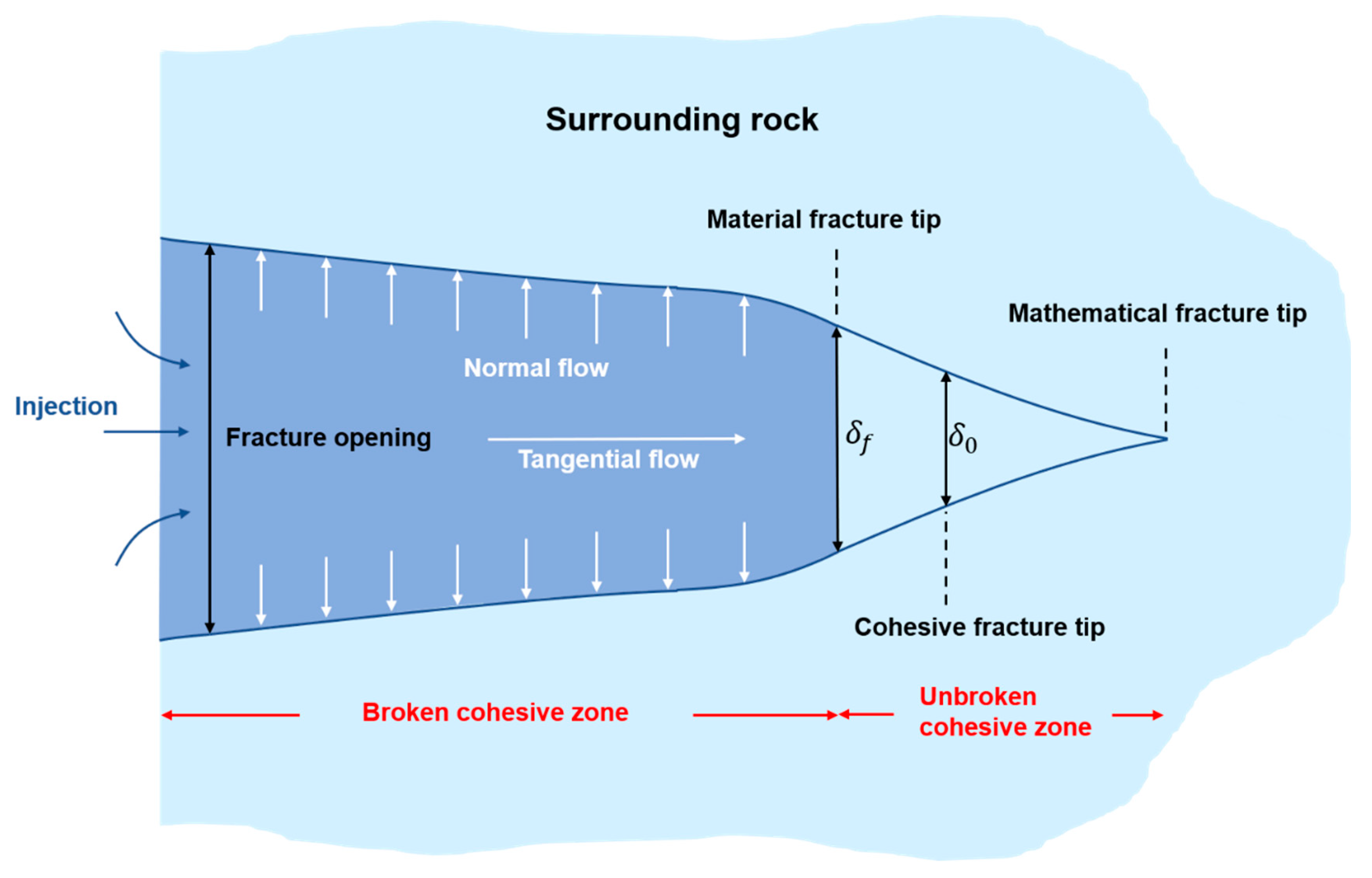

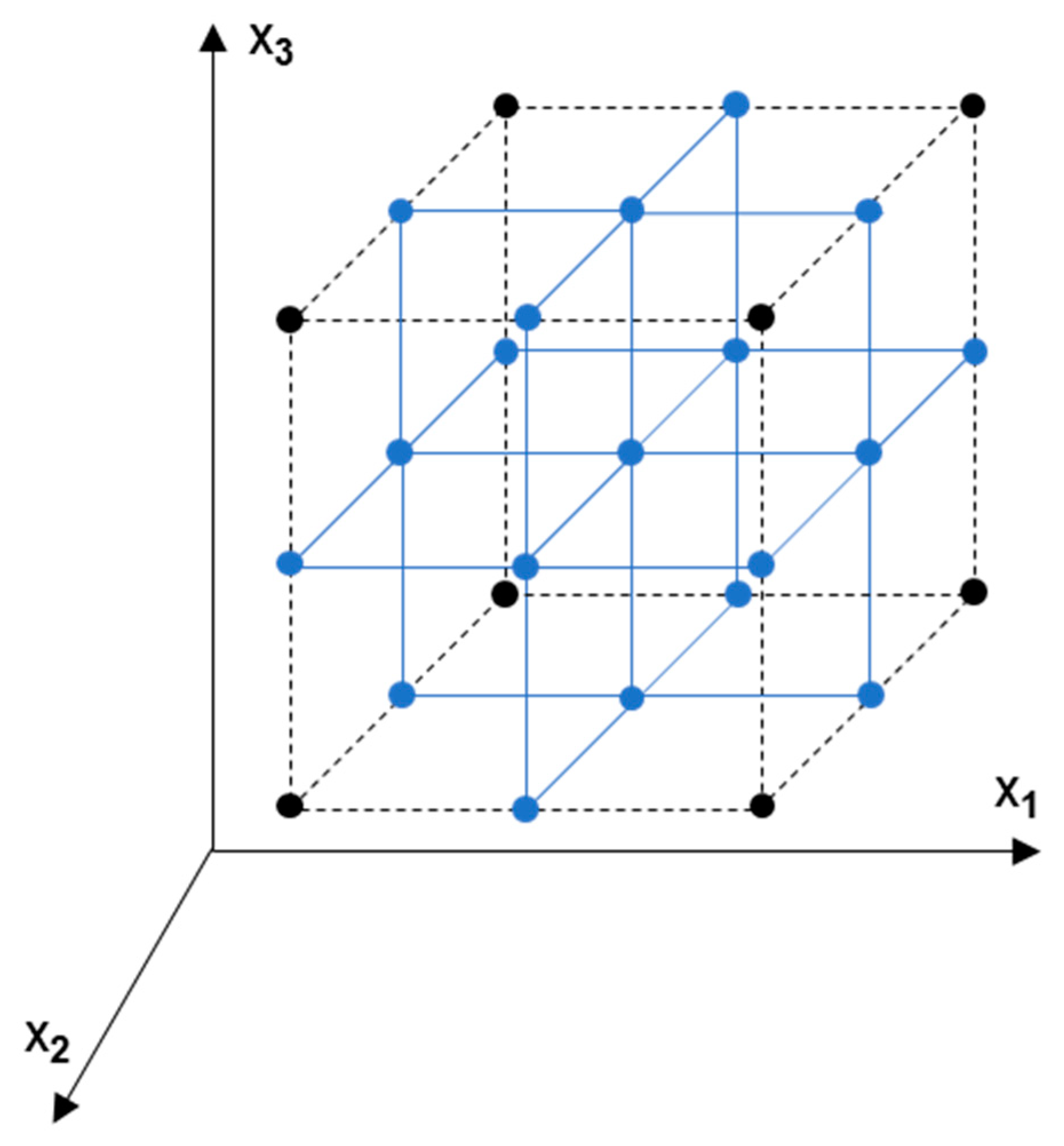
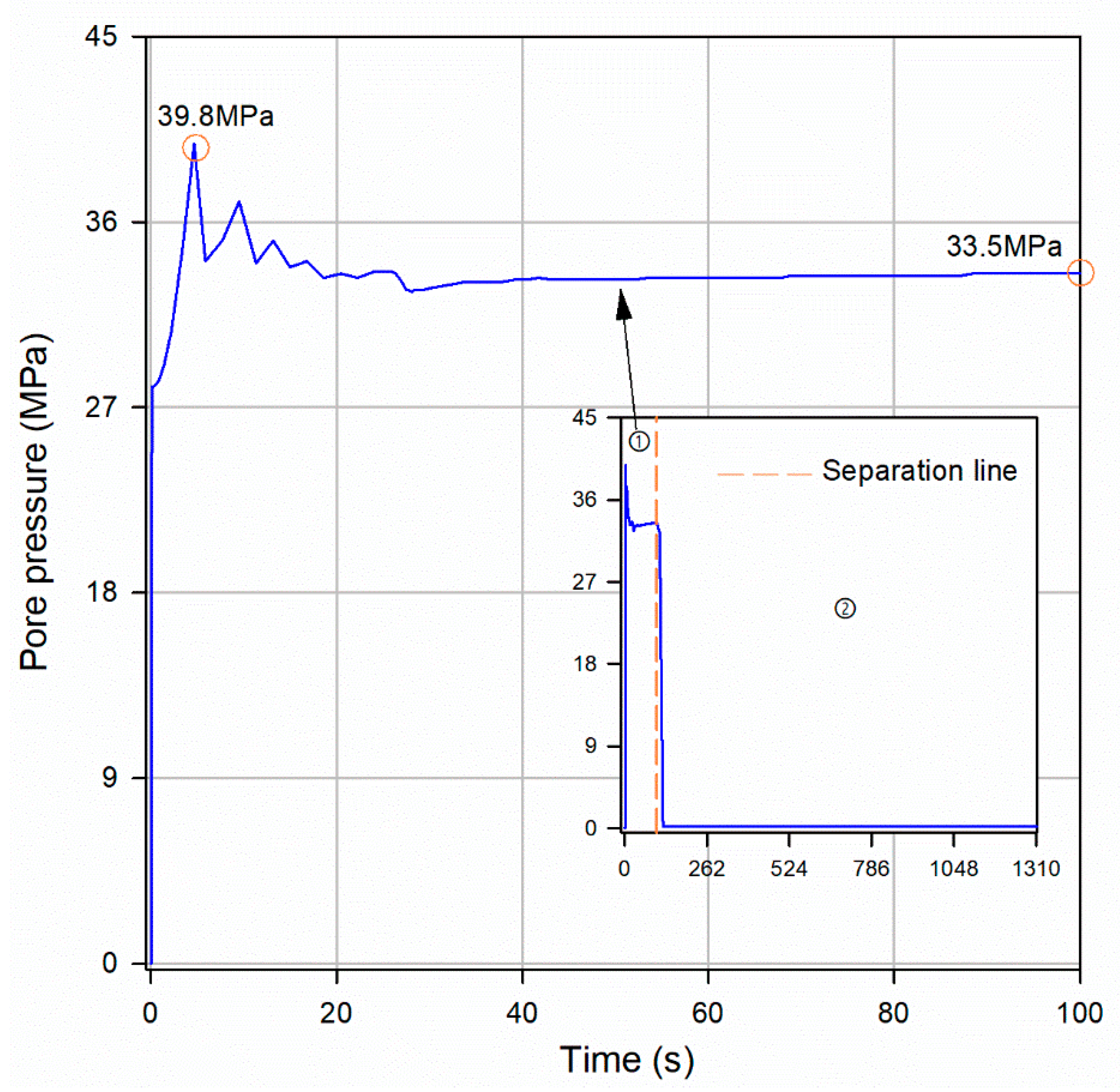

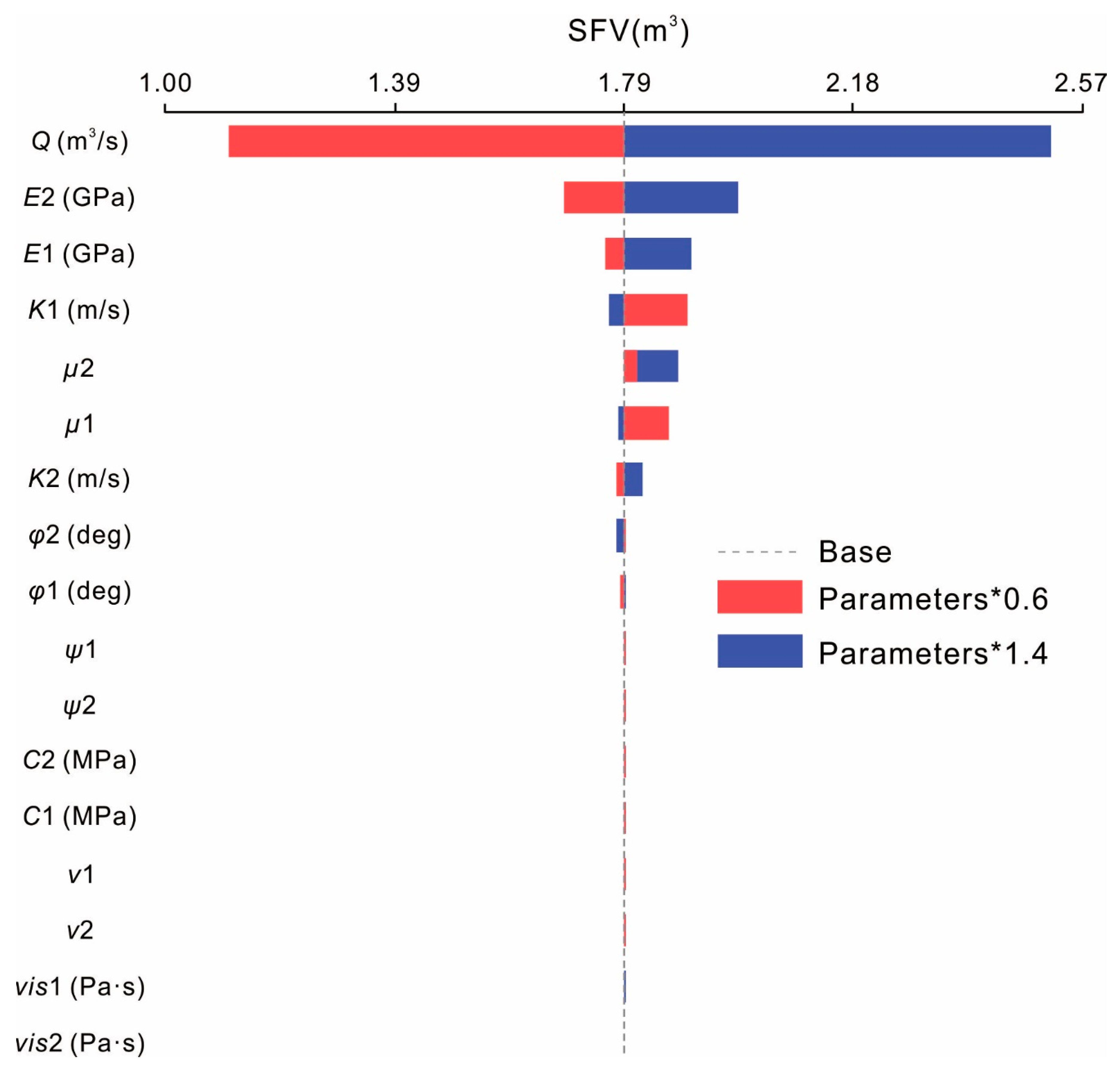

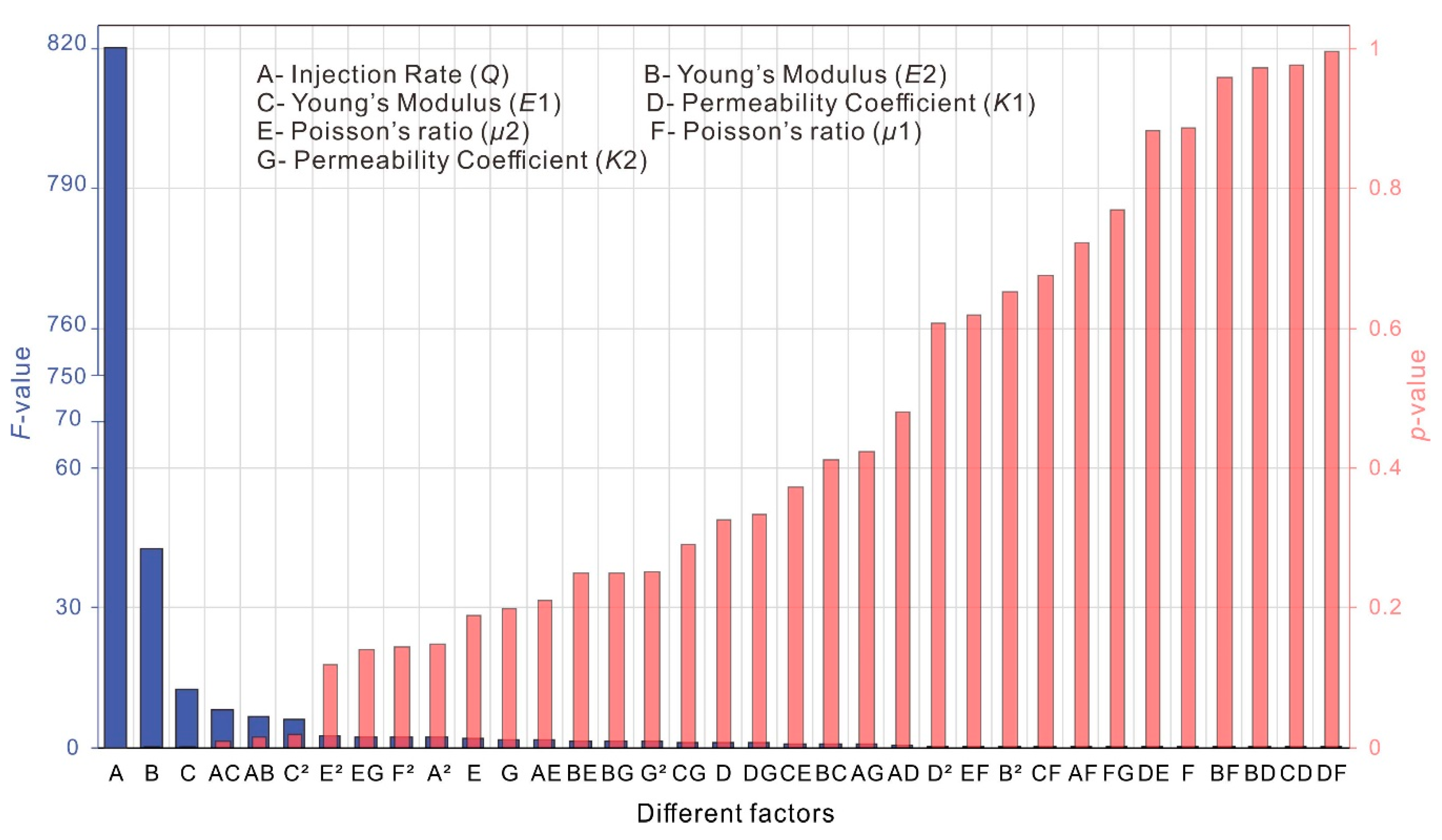
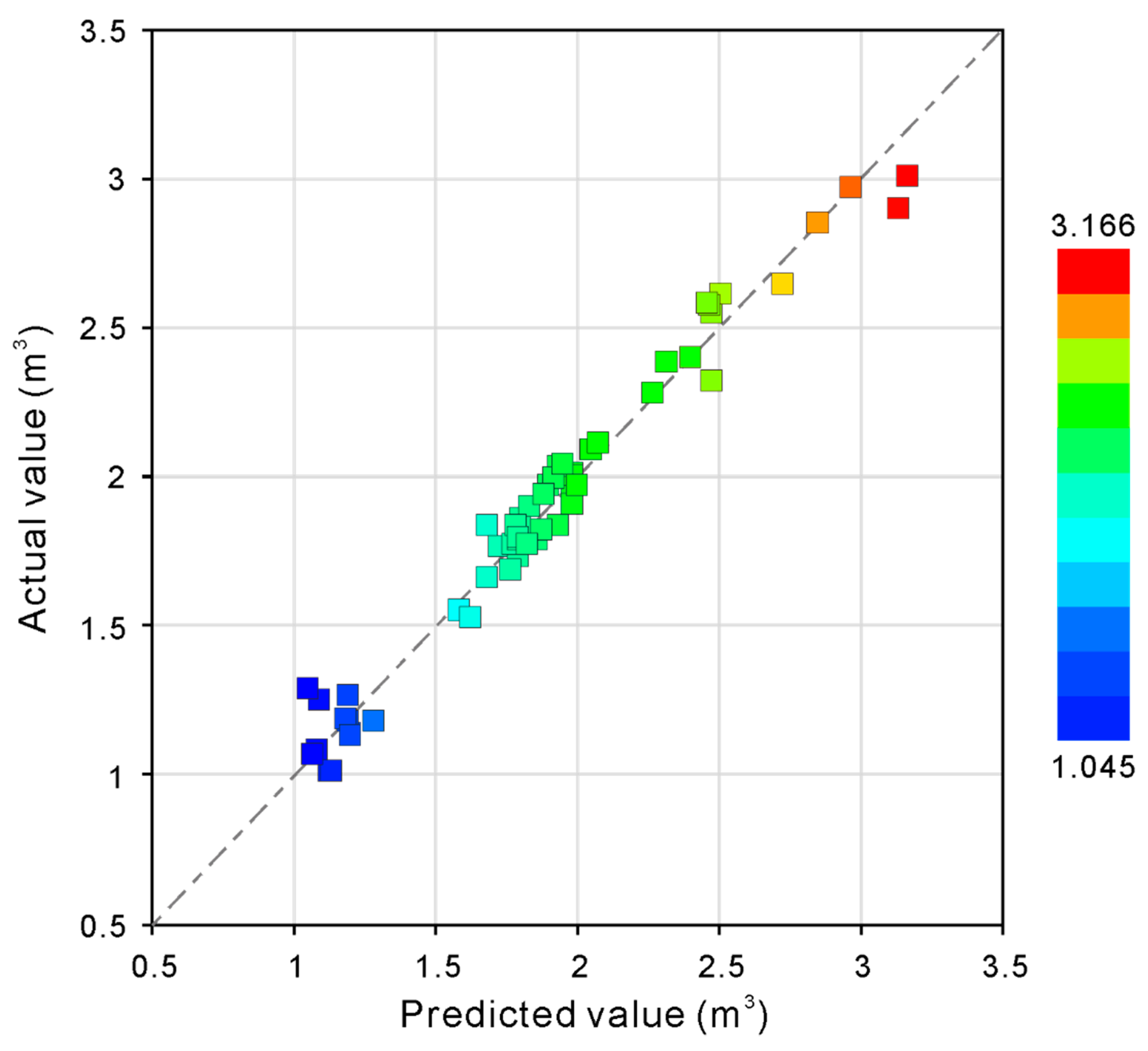

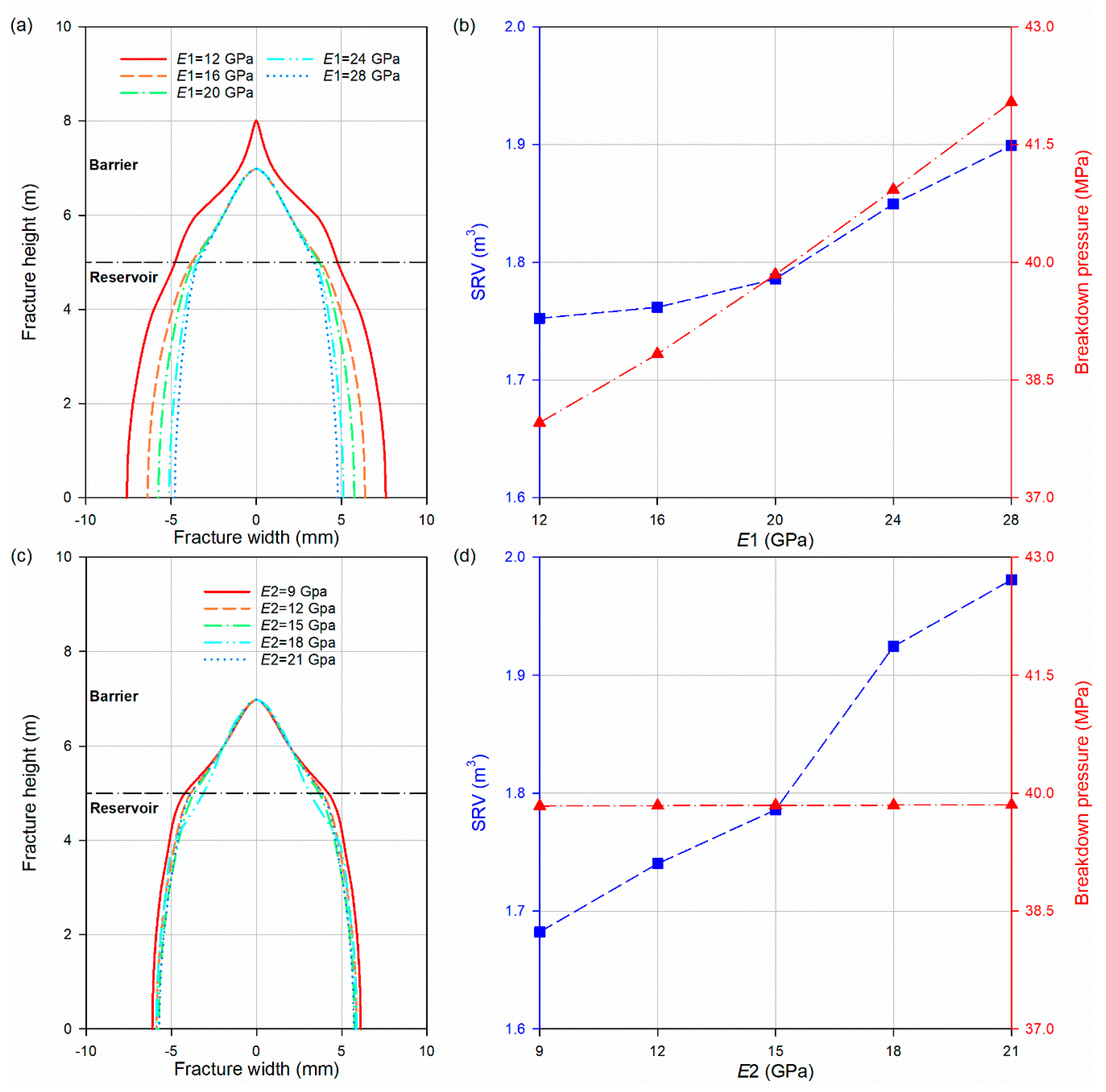


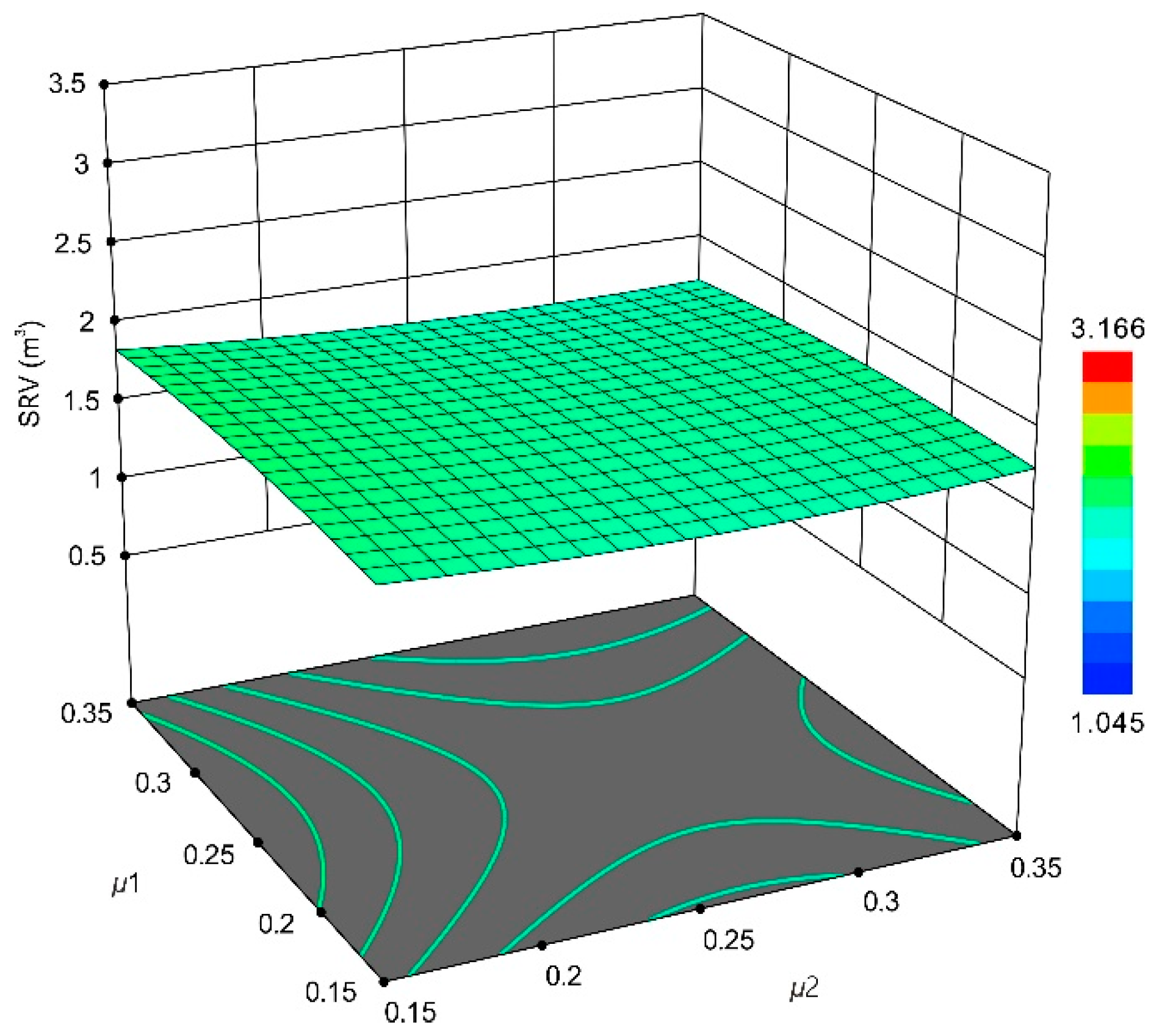
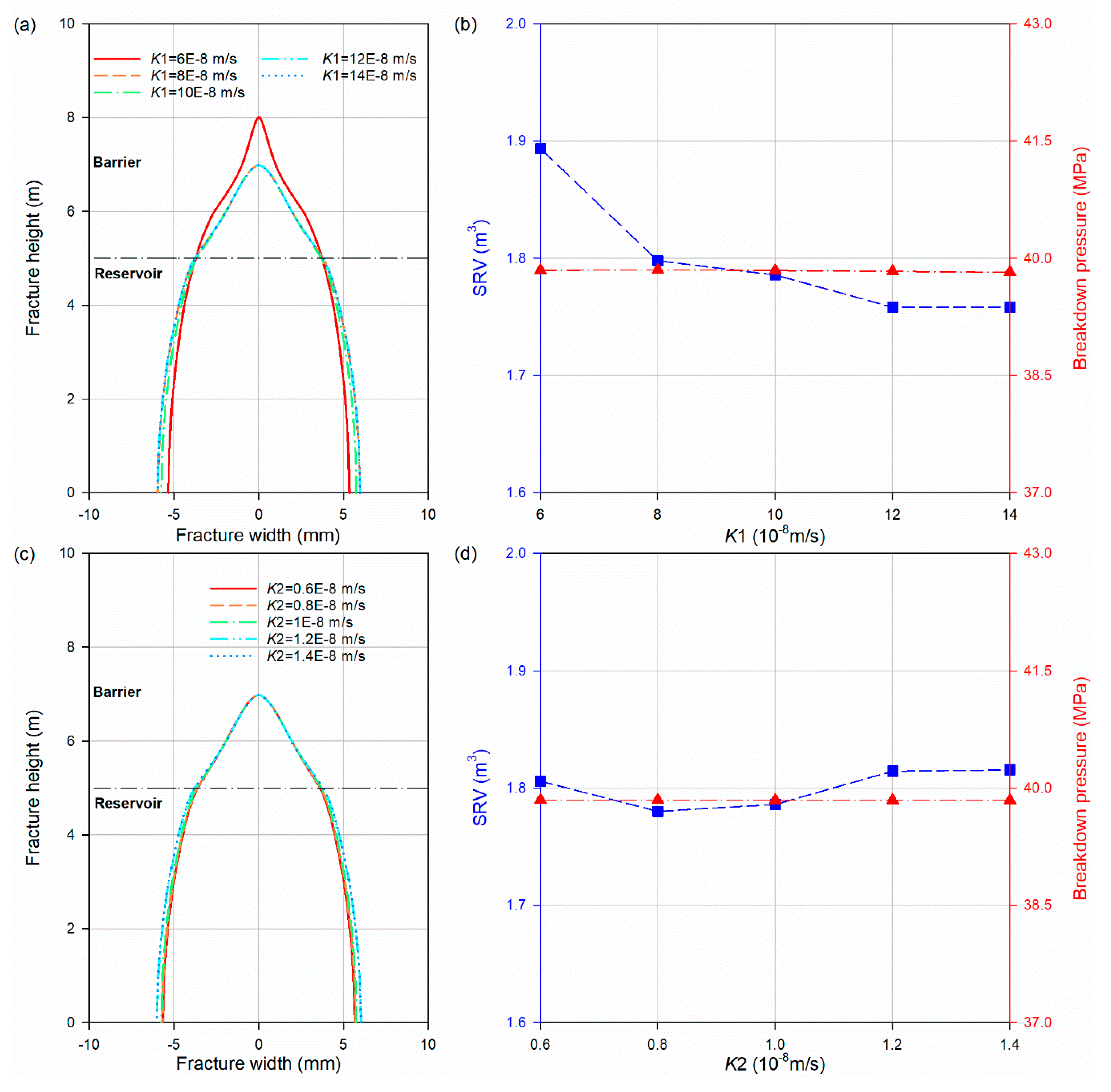
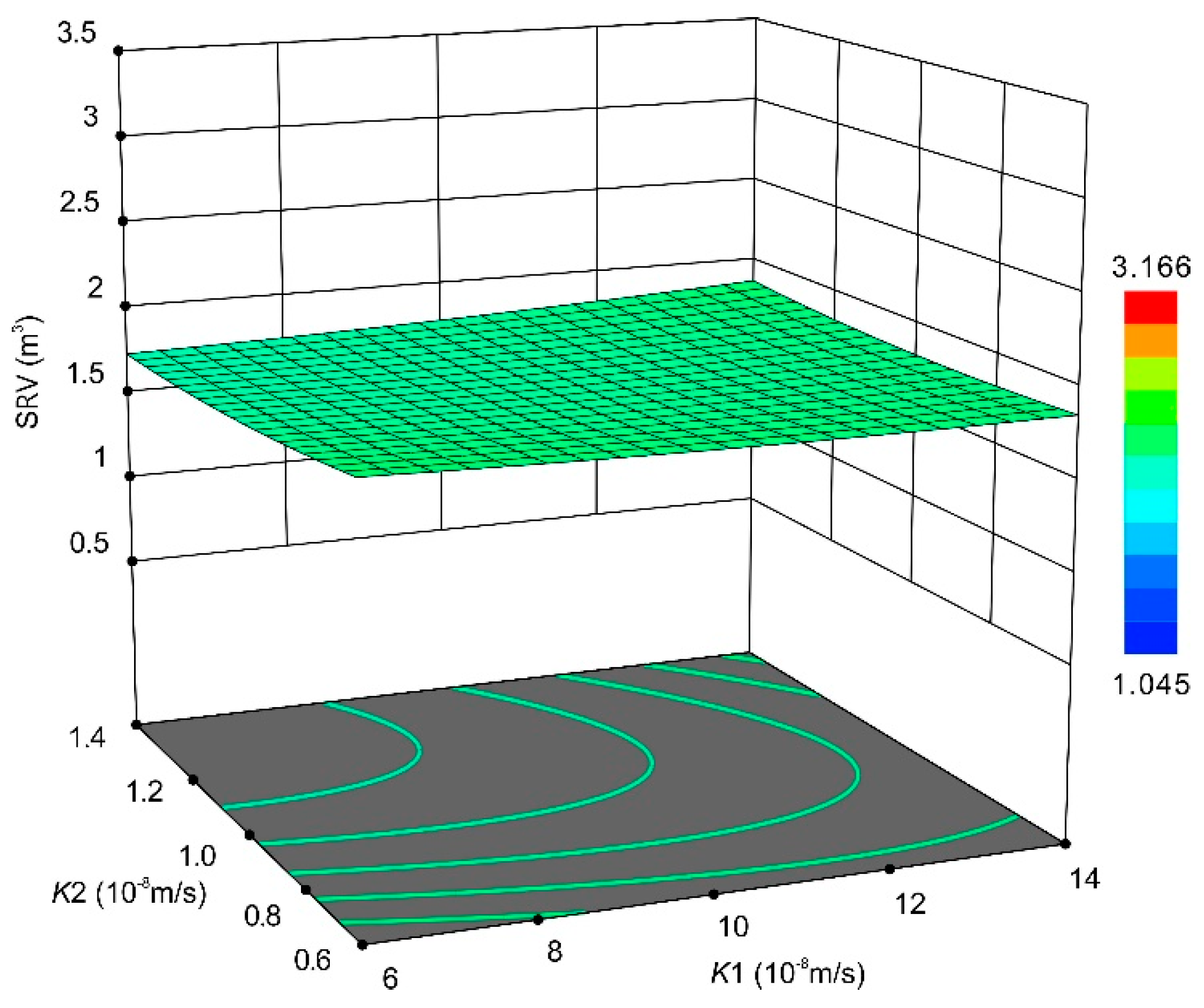
| Parameter | Reservoir | Barrier | Unit |
|---|---|---|---|
| Young’s modulus | 20 | 15 | GPa |
| Poisson’s ratio | 0.25 | 0.25 | - |
| Friction angle | 25 | 30 | deg |
| Cohesion | 11 | 8 | MPa |
| Dilatancy angle | 20 | 25 | deg |
| Initial permeability | 1.0 10−7 | 1.0 10−8 | m/s |
| Void ratio | 0.2 | 0.2 | - |
| Stratum | Parameters | Maximum | Median (Benchmark) | Minimum | Unit |
|---|---|---|---|---|---|
| Reservoir | Injection rate (Q) | 0.014 | 0.001 | 0.006 | m3/s |
| Young’s modulus (E1) | 28 | 20 | 12 | GPa | |
| Poisson’s ratio (μ1) | 0.35 | 0.25 | 0.15 | - | |
| Friction angle (φ1) | 35 | 25 | 15 | deg | |
| Cohesion (C1) | 15.4 | 11 | 6.6 | MPa | |
| Permeability coefficient (K1) | 14 | 10 | 6 | 10−8 m/s | |
| Void ratio (ν1) | 0.28 | 0.2 | 0.12 | - | |
| Dilatancy angle (ψ1) | 28 | 20 | 12 | deg | |
| Viscosity (vis1) | 0.0014 | 0.001 | 0.0006 | Pa·s | |
| Barrier | Young’s modulus (E2) | 21 | 15 | 9 | GPa |
| Poisson’s ratio (μ2) | 0.35 | 0.25 | 0.15 | - | |
| Friction angle (φ2) | 42 | 30 | 18 | deg. | |
| Cohesion (C2) | 11.2 | 8 | 4.8 | MPa | |
| Permeability coefficient (K2) | 1.4 | 1 | 0.6 | 10−8 m/s | |
| Void ratio (ν2) | 0.28 | 0.2 | 0.12 | - | |
| Dilatancy angle (ψ2) | 35 | 25 | 15 | deg | |
| Viscosity (vis2) | 0.0014 | 0.001 | 0.006 | Pa·s |
| Run | Factor A: | Factor B: | Factor C: | Factor D: | Factor E: | Factor F: | Factor G: | SRV |
|---|---|---|---|---|---|---|---|---|
| Q (m3/s) | E2 (GPa) | E1 (GPa) | K1 (10−8 m/s) | μ2 | μ1 | K2 (10−8 m/s) | (m3) | |
| 1 | 0.01 | 15 | 20 | 10 | 0.25 | 0.25 | 1 | 1.786 |
| 2 | 0.01 | 21 | 28 | 10 | 0.25 | 0.15 | 1 | 2.048 |
| 3 | 0.01 | 9 | 20 | 10 | 0.15 | 0.25 | 0.6 | 1.723 |
| 4 | 0.01 | 15 | 12 | 14 | 0.25 | 0.25 | 1.4 | 1.928 |
| 5 | 0.01 | 15 | 12 | 6 | 0.25 | 0.25 | 0.6 | 1.978 |
| 6 | 0.006 | 9 | 20 | 6 | 0.25 | 0.25 | 1 | 1.081 |
| 7 | 0.01 | 15 | 20 | 10 | 0.25 | 0.25 | 1 | 1.786 |
| 8 | 0.014 | 15 | 20 | 10 | 0.25 | 0.35 | 1.4 | 2.474 |
| 9 | 0.01 | 21 | 20 | 10 | 0.15 | 0.25 | 1.4 | 1.982 |
| 10 | 0.006 | 15 | 20 | 10 | 0.25 | 0.15 | 1.4 | 1.115 |
| 11 | 0.01 | 15 | 20 | 6 | 0.35 | 0.15 | 1 | 1.85 |
| 12 | 0.01 | 21 | 20 | 10 | 0.35 | 0.25 | 0.6 | 1.978 |
| 13 | 0.01 | 9 | 12 | 10 | 0.25 | 0.35 | 1 | 1.582 |
| 14 | 0.014 | 15 | 28 | 10 | 0.15 | 0.25 | 1 | 3.166 |
| 15 | 0.01 | 9 | 12 | 10 | 0.25 | 0.15 | 1 | 1.621 |
| 16 | 0.014 | 9 | 20 | 14 | 0.25 | 0.25 | 1 | 2.395 |
| 17 | 0.006 | 15 | 12 | 10 | 0.35 | 0.25 | 1 | 1.083 |
| 18 | 0.01 | 9 | 20 | 10 | 0.35 | 0.25 | 1.4 | 1.675 |
| 19 | 0.01 | 15 | 20 | 6 | 0.35 | 0.35 | 1 | 1.787 |
| 20 | 0.006 | 15 | 28 | 10 | 0.15 | 0.25 | 1 | 1.193 |
| 21 | 0.006 | 21 | 20 | 14 | 0.25 | 0.25 | 1 | 1.19 |
| 22 | 0.01 | 9 | 20 | 10 | 0.15 | 0.25 | 1.4 | 1.682 |
| 23 | 0.01 | 9 | 20 | 10 | 0.35 | 0.25 | 0.6 | 1.678 |
| 24 | 0.01 | 15 | 12 | 6 | 0.25 | 0.25 | 1.4 | 1.759 |
| 25 | 0.01 | 15 | 20 | 14 | 0.35 | 0.35 | 1 | 1.768 |
| 26 | 0.014 | 15 | 28 | 10 | 0.35 | 0.25 | 1 | 3.137 |
| 27 | 0.014 | 15 | 20 | 10 | 0.25 | 0.15 | 1.4 | 2.507 |
| 28 | 0.006 | 21 | 20 | 6 | 0.25 | 0.25 | 1 | 1.178 |
| 29 | 0.01 | 15 | 20 | 10 | 0.25 | 0.25 | 1 | 1.786 |
| 30 | 0.01 | 15 | 28 | 6 | 0.25 | 0.25 | 0.6 | 1.928 |
| 31 | 0.01 | 21 | 20 | 10 | 0.15 | 0.25 | 0.6 | 2.472 |
| 32 | 0.014 | 15 | 20 | 10 | 0.25 | 0.35 | 0.6 | 2.459 |
| 33 | 0.006 | 15 | 20 | 10 | 0.25 | 0.35 | 0.6 | 1.278 |
| 34 | 0.006 | 15 | 28 | 10 | 0.35 | 0.25 | 1 | 1.184 |
| 35 | 0.014 | 15 | 20 | 10 | 0.25 | 0.15 | 0.6 | 2.456 |
| 36 | 0.014 | 21 | 20 | 14 | 0.25 | 0.25 | 1 | 2.962 |
| 37 | 0.01 | 15 | 20 | 14 | 0.35 | 0.15 | 1 | 1.872 |
| 38 | 0.014 | 15 | 12 | 10 | 0.15 | 0.25 | 1 | 2.718 |
| 39 | 0.01 | 15 | 20 | 10 | 0.25 | 0.25 | 1 | 1.786 |
| 40 | 0.01 | 15 | 20 | 14 | 0.15 | 0.15 | 1 | 1.797 |
| 41 | 0.01 | 15 | 28 | 6 | 0.25 | 0.25 | 1.4 | 1.896 |
| 42 | 0.006 | 15 | 12 | 10 | 0.15 | 0.25 | 1 | 1.045 |
| 43 | 0.01 | 9 | 28 | 10 | 0.25 | 0.15 | 1 | 1.795 |
| 44 | 0.006 | 15 | 20 | 10 | 0.25 | 0.35 | 1.4 | 1.129 |
| 45 | 0.014 | 21 | 20 | 6 | 0.25 | 0.25 | 1 | 2.847 |
| 46 | 0.014 | 15 | 12 | 10 | 0.35 | 0.25 | 1 | 2.313 |
| 47 | 0.006 | 9 | 20 | 14 | 0.25 | 0.25 | 1 | 1.061 |
| 48 | 0.01 | 15 | 20 | 14 | 0.15 | 0.35 | 1 | 1.825 |
| 49 | 0.01 | 21 | 20 | 10 | 0.35 | 0.25 | 1.4 | 1.999 |
| 50 | 0.01 | 15 | 12 | 14 | 0.25 | 0.25 | 0.6 | 1.976 |
| 51 | 0.01 | 21 | 12 | 10 | 0.25 | 0.35 | 1 | 1.994 |
| 52 | 0.006 | 15 | 20 | 10 | 0.25 | 0.15 | 0.6 | 1.194 |
| 53 | 0.014 | 9 | 20 | 6 | 0.25 | 0.25 | 1 | 2.261 |
| 54 | 0.01 | 15 | 28 | 14 | 0.25 | 0.25 | 0.6 | 1.914 |
| 55 | 0.01 | 15 | 20 | 10 | 0.25 | 0.25 | 1 | 1.786 |
| 56 | 0.01 | 15 | 20 | 10 | 0.25 | 0.25 | 1 | 1.786 |
| 57 | 0.01 | 15 | 28 | 14 | 0.25 | 0.25 | 1.4 | 2.067 |
| 58 | 0.01 | 21 | 28 | 10 | 0.25 | 0.35 | 1 | 1.942 |
| 59 | 0.01 | 15 | 20 | 6 | 0.15 | 0.35 | 1 | 1.776 |
| 60 | 0.01 | 21 | 12 | 10 | 0.25 | 0.15 | 1 | 1.882 |
| 61 | 0.01 | 15 | 20 | 6 | 0.15 | 0.15 | 1 | 1.789 |
| 62 | 0.01 | 9 | 28 | 10 | 0.25 | 0.35 | 1 | 1.822 |
© 2019 by the authors. Licensee MDPI, Basel, Switzerland. This article is an open access article distributed under the terms and conditions of the Creative Commons Attribution (CC BY) license (http://creativecommons.org/licenses/by/4.0/).
Share and Cite
Zhang, J.; Liu, X.; Wei, X.; Liang, L.; Xiong, J.; Li, W. Uncertainty Analysis of Factors Influencing Stimulated Fracture Volume in Layered Formation. Energies 2019, 12, 4444. https://doi.org/10.3390/en12234444
Zhang J, Liu X, Wei X, Liang L, Xiong J, Li W. Uncertainty Analysis of Factors Influencing Stimulated Fracture Volume in Layered Formation. Energies. 2019; 12(23):4444. https://doi.org/10.3390/en12234444
Chicago/Turabian StyleZhang, Jingxuan, Xiangjun Liu, Xiaochen Wei, Lixi Liang, Jian Xiong, and Wei Li. 2019. "Uncertainty Analysis of Factors Influencing Stimulated Fracture Volume in Layered Formation" Energies 12, no. 23: 4444. https://doi.org/10.3390/en12234444






